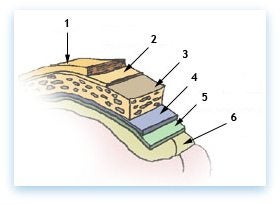SubArachnoid Hemorrhage
• A subarachnoid hemorrhage is a bleeding in the brain in the meninges between brain and skull. To be more precise: a bleeding under the arachnoid in the subarachnoid space.
• There is a one centimer wide space in which the afferent and draining vessels to and from the brain are located.
• In one of the afferent blood vessels, the main artery, there can be a sort of balloon an aneurysm.
• If the balloon expands and bursts a bleeding occurs between the brains and the skull.
MENINGES

• The meninges are located around the brains. The meninges perform a function in the supply to the brains and also serve as a pad for the protection of the brains. The layers around the brains are (from outside to inside)
• Scalp (1)
• Periosteum (2)
• Bone (3)
• Dural (Dura Mater 4)
• Arachnoid (5)
• Subarachnoid space
• Soft meningeal (Pia mater 6)
• If a blood vessel bursts or tears a bleeding occurs in this brain area. The brain cells in that area don’t get enough oxygen and / or nutrients and then die.
• The flowing blood creates more pressure or swelling in this brain region. Bleeding may result from hypertension or congenital vascular disease, atherosclerosis, aneurysm.
READ MORE ABOUT EFFECTS AND OTHER INFO
Because the subarachnoid hemorrhage is cerebral hemorrhage for additional information we refer to the page about cerebral hemorrhage.
On the website about SAH of the stroke center you can find more information about SAH.
Causes of SAH
Brain aneurysm
The cause of a SAH is in most cases (85%) the bursting of a brain aneurysm. An aneurysm is a dilation in the blood vessels (sometimes a balloon) that over time has become a weakness in the blood vessel. In some people, these aneurysms occur in the brain, usually in an important network of blood vessels located at the bottom of the brain. Such an aneurysm often bursts when there is a sudden large increase in blood pressure due to, for example, physical activity, but it can also burst 'out of the blue'. In many cases, whether you have such an aneurysm is bad luck.
Smoking, alcohol and drug use are risk factors for developing an aneurysm. Hereditary predisposition also plays a role. Women are more likely to develop an aneurysm than men.
Arteriovenous malformation
A tangle of blood vessels, also called an arteriovenous malformation (AVM), can be another cause. An AVM, like an aneurysm, is a weak spot in the blood vessel system that can cause bleeding.
Perimesencephalic hemorrhage
Perimesencephalic hemorrhage is a bleeding around the midbrain (mesencephalon).
The blood from the hemorrhage accumulates in the reservoirs of the midbrain. A perimesencephalic hemorrhage is a subarachnoid hemorrhage that is not caused by an aneurysm.
About 10% of SAH hemorrhages are perimesencephalic hemorrhages.
Sometimes there is hardly any physical loss.
Complications, such as hydrocephalus, reduced blood flow to the brain (cerebral ischemia) and new bleeding, only rarely occur.
The prognosis in terms of survival and clinical course is generally better than with SAH after an aneurism, but there are often many consequences in terms of fatigue and stimulus processing or cognitive complaints.
These are examples of invisible consequences of brain injury. According to researchers, a third of people with perisencephalic hemorrhage still suffer from it after five years. See, for example, this study.
It is therefore recommended to also give these groups of patients a long-term follow-up after discharge from the hospital.
Cause unknown
In approximately 5% of cases, no underlying cause of SAH is found. It could possibly be due to trauma/blow to the head, but no aneurysm is found. This group of people may be slightly better off because the risk of complications is lower.